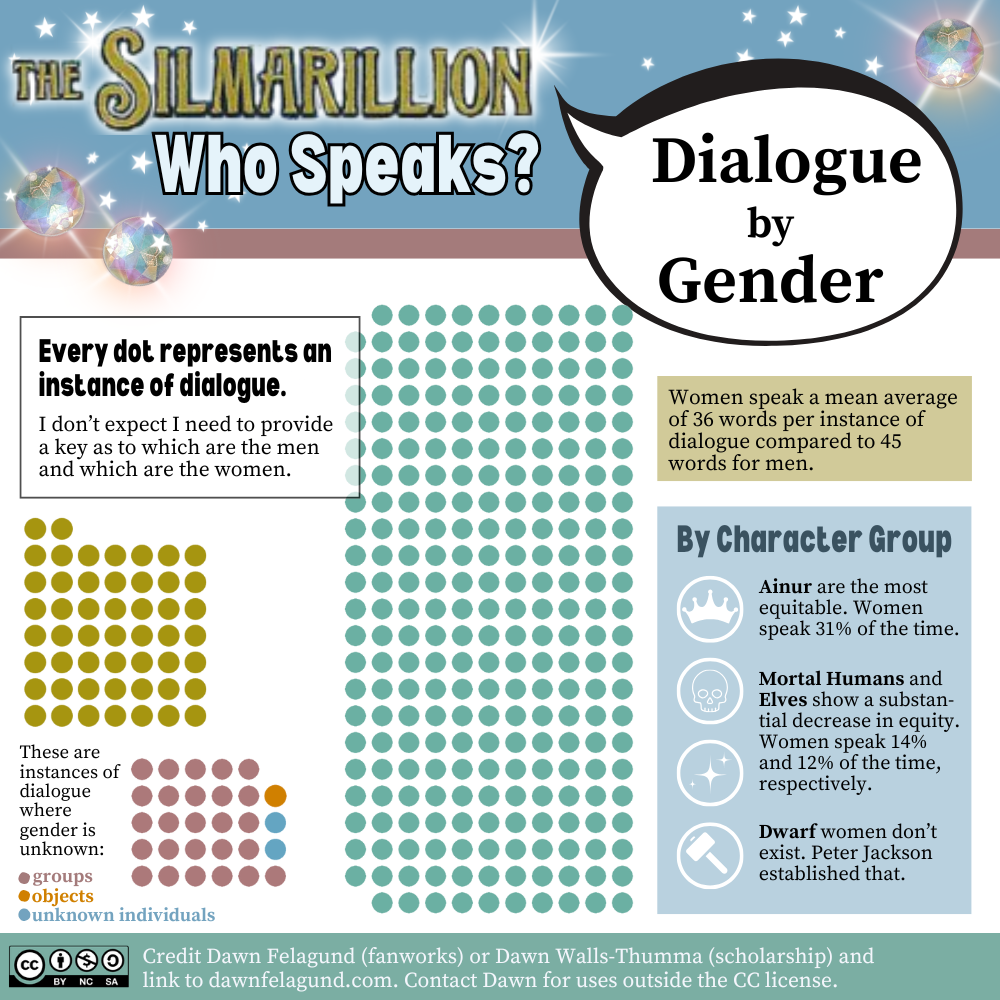New Challenge: Musicals
Prompts this month come from musicals.
The Silmarillion: Who Speaks? by Dawn Felagund
Dialogue by Gender

I expect the outcome of these data will surprise no one. Women speak less, and women speak less. This isn't a typo: It means that they have fewer instances of dialogue in The Silmarillion by a substantial margin, and when they do speak, they speak nine fewer words than men, on average.
Instances of women speaking is much nearer to speakers of unknown gender than to men speaking. (And before we get excited and think that the "unknown gender" speakers are rejecting the gender binary, this category represents mostly dialogue attributed to a group, plus two unnamed individuals who are given dialogue and one sword.)
This matters because dialogue signifies several important things in The Silmarillion. First, in a pseudohistorical text like The Silmarillion, direct quotes mean that someone said something important enough to preserve in the historical record. Men, based on the data, are saying far more important things than women, at least in the various narrators' estimation. Next, dialogue is often a proxy to action: Characters debate, give directives, and make speeches. Dialogue also humanizes, and even though Tolkien rejects many modern literary techniques in The Silmarillion, he does use dialogue as a characterization technique. As I will show in future analyses, some characters are distinguishable based on how they speak.
Of course, the reduced dialogue of women in The Silmarllion is a direct effect of there being significantly fewer women than men: Women constitute only 19% of the named characters in The Silmarillion. Even given this, however, women speak less than we would expect.
When we look at character groups, there are notable differences, namely that women of the Ainur speak more than Mortal Human and Elven women do. (Only four Elven women and five Mortal Human women speak in The Silmarillion! Excuse me while I scream!) This was the thesis of the long-ago Inequality Prototype that spurred this data collection endeavor: The Valar, being prototypical, show an equal penchant for entering into the world based on gender: It is a 50/50 split. So we can't say that women have less desire to influence the world than men in the legendarium. When we see less action and fewer instances of dialogue among women, then, we have to ask why.
Complicating the data for the Ainur (overall, not just this set) is the fact that a big chunk of their dialogue occurs in the "Of Aulë and Yavanna" chapter that Christopher Tolkien wrote. I don't want to treat these data differently until I have the opportunity to collect more data on where dialogue outside this chapter comes from; for all I know, Christopher wrote most of it! (Actually, I know he didn't, but this chapter does illustrate how his additions can skew data for a particular group, in this case the Ainur.)
Another future area of inquiry will be the type or purpose of the dialogue and whether/how this varies based on gender. Characters speak for many reasons. Do women speak for different purposes than men?
If these data illustrate anything to me, it is the importance of fanworks in amplifying the voices of women characters who we know existed and know said and did things that mattered. We are being given a historical record much like our own Modern-earth historical record: biased toward the contributions of some over others. Only we can fix that.

